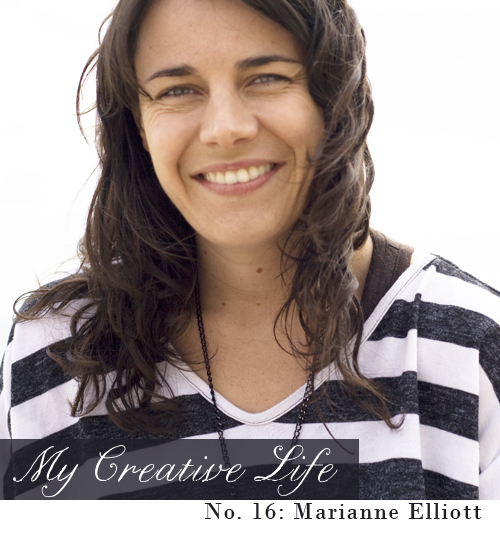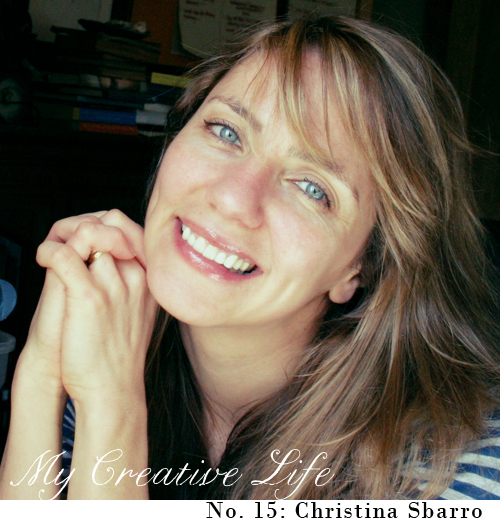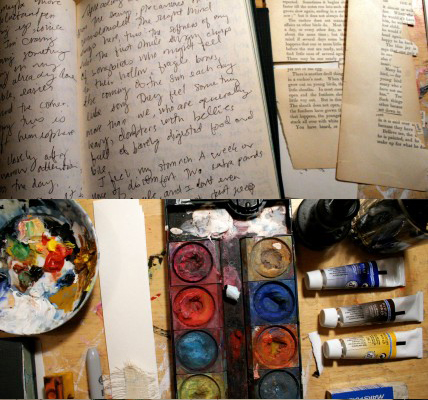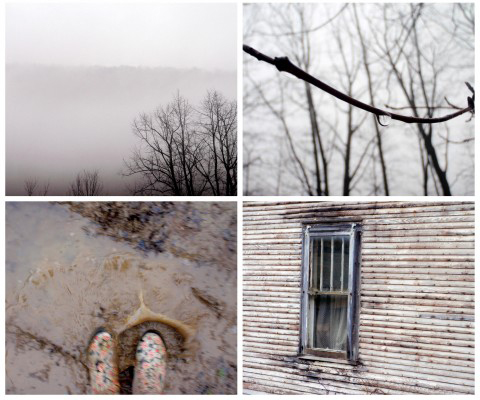 I first met Marianne Elliott in 2007 when she arrived at my front door carrying a small rucksack and a yoga mat; she was in the UK on leave from her job as a Human Rights Officer in Afghanistan and after finding each other via our blogs she made her way to the sea to see me; as often happens with these blog-meet-ups we discovered we were sisters under the skin. I’ll never forget the sight of Marianne doing yoga in my living room as i searched for my cigarettes (I was still a committed smoker back then!)
I first met Marianne Elliott in 2007 when she arrived at my front door carrying a small rucksack and a yoga mat; she was in the UK on leave from her job as a Human Rights Officer in Afghanistan and after finding each other via our blogs she made her way to the sea to see me; as often happens with these blog-meet-ups we discovered we were sisters under the skin. I’ll never forget the sight of Marianne doing yoga in my living room as i searched for my cigarettes (I was still a committed smoker back then!)
These days Marianne is back in her native New Zealand, teaching yoga, writing her memoir and basically saving the world :) I love her and I hope you guys will too – please welcome Marianne!
SC: Did you always know you were a writer? Tell us about your path into this career.
ME: I always dreamed of being a writer. When I was a wee little thing I thought I was a writer; I wrote great long stories inspired by Spike Milligan and J R R Tolkien. I even started a magazine with my best friend when I was about 12 years old; we wrote articles about the birds nesting in the trees up behind our church and guides on how to care for the ponies we didn’t have. We didn’t have photocopiers or computers, so we only produced one copy of each edition, which we then took turns lending to our friends and family.
But somewhere along the way I lost confidence in my creative writing. I became an accomplished professional writer, able to churn out reports on human rights in Afghanistan in my sleep, but I was unsure about my ability to write creatively.
The confidence to write creatively returned to me slowly through the process of writing my blog. After writing regularly on my blog for several years I decided to try to write a book about my experiences in Afghanistan. That was two years ago now and I’m now in the process of working with my agent (Laura Nolan of De Fiore and Company) to revise my manuscript so that we can send it out to publishers. My path has been one of repeatedly facing my fear that my writing won’t be good enough and then writing anyway. I suspect it will continue that way for a long time.
Please describe a typical day…
My days vary a lot depending on whether or not I’m going into the office for my work as a human rights consultant, which I do at least three days per week.
6 am: In the morning I either write, meditate, do yoga or sleep in and then rush around like a crazy person to get out the door. Obviously some of these options start my day off better than others, but I can live with any of them as long as I have tea.
7 am: Out the door. If it’s reasonable weather I walk to work otherwise I take the bus. On the bus or while I’m walking I do some morning meditation. It’s a stunning walk, more than an hour up and over Mt Victoria with a view of Wellington harbour. This walk is currently my spiritual practice and my most consistent form of morning ‘yoga’.
8.30 – 5.30 pm: I work as a human rights consultant which means anything from developing tools and materials to help NGOs in the Pacific advocate for fairer trade rules to interviewing people in Wellington about how their disability affects their day to day lives. I contract to government, non-government and inter-governmental organizations and my work sometimes requires travel around New Zealand or the Pacific. If I’m travelling my typical day looks quite different.
6.00 – 7.30 pm: I teach yoga five nights a week. Some of the classes start later, at 7.00 pm, in which case I try to get in my own yoga practice before I teach. On the nights when the class starts earlier I depend on fifteen minutes in the room alone before the students arrive to ground myself and connect with my wisest inner teacher, the part of me that always knows the perfect response to every person and moment that shows up.
I generally get home between 8.30 – 9.30 pm. I make myself some dinner, or eat a takeaway salad that I picked up on the way home, and settle in to work for the evening. In the evening do the work for my 30 days of yoga course (customising yoga videos, responding to questions, posting the regular updates etc), write guest posts for other blogs and catch up on Twitter, which is by far my favourite form of social media.
I try to get off the computer by 11pm and make a little time to unwind with a little restorative yoga (lying with my legs up the wall is a favourite) before getting to bed before midnight. Lately I’ve been teaching myself to crochet. I have ten nieces and nephews and it seems at least one of my friends is having a baby every month so I’ve decided I need to follow my Grandmother’s example and start crocheting baby blankets. Crocheting is a great way for me to unwind in the evening, my brain can start to switch off and prepare for sleep.

Tell us more about 30 days of yoga.
30 days of yoga is an online program designed to support you to begin or restart a regular practice of yoga in the comfort of your own home. Lots of people struggle to get along to yoga classes regularly or to establish a regular practice of yoga at home. That might be because they run their own creative business from home, it might be because they live a hundred miles from the nearest yoga studio (or further, I have participants living in Afghanistan, Kosovo and South Sudan) or it might be because they find the idea of showing up at a yoga class horrifying, especially if they have to wear Lycra pants. If you are one of those people, I designed this programme for you.
You don’t need to know anything about yoga – the programme also works really well for people who already practice yoga but want to establish or deepen their home practice. You don’t even need a yoga mat. Most of the time I practice on the carpet rug in our living room. I design the practices in sections or modules so that if you have 10 minutes you can do just the first section. If you have 20 minutes you can do two sections etc. All you need is the intention to discover what is right for you and the commitment to give yourself what you really need.
There are two ways to participate in the 30 days. Option One is called Exactly What You Need – I provide participants with a yoga video selected just for them based on their answers to a simple questionnaire. Option Two is called You Know What You Need – this is for people who already practice yoga, know how to put together their own home practice and are looking for support, advice and encouragement to actually stick with a regular home practice over the 30 days and beyond.
The next 30 days starts on 12 June.
How does your yoga support your writing?
My life is very full and I learned a long time ago that I can only sustain this kind of pace if I am really healthy – so one way in which my yoga supports my writing is simply by giving me the fitness and focus to work or write solidly for twelve to fourteen hours a day. I wouldn’t be able to get this book written if I didn’t have that stamina and focus and I attribute a lot of it to yoga.
Yoga also reminds me, over and over again, that the only place to start is exactly where I am. Writing works exactly the same way. Every day when I sit down to write I have to first agree with myself to accept myself and my writing exactly as it is on that particular day. There is a profound kindness in yoga, in the practice of meeting and accepting ourselves just as we are and that kindness has transformed both my process of writing and, I think, the content of my writing.

You have a lot going on in your life – writing, teaching yoga, working as a human rights consultant. What’s the connection between all these threads?
I believe that we all have a unique way to serve the world. Part of my purpose in life is to support and motivate others to find and own their own authentic place in the world and their own unique way to serve the world. All the work I do is connected to this purpose.
The ‘30 days of yoga’ course focuses very strongly on each participant creating an authentic practice of yoga, something that suits and supports them to continuing connecting into their truest self.
The ‘Yoga in Action’ courses that I facilitate here in New Zealand, are a seven week process to get help people clarify their unique purpose, their vision and their community and then develop spiritual and well-being practices that will sustain them as they begin to live the kind of full, abundant lives that we tend to have when we are living on our true purpose.
In my writing, I aspire to tell stories that remind us all that the world can be a place of kindness, that we are all each other’s people, that together we are enough. I hope that these stories will remind us all of the essential place we have in the world and of the potential we have to serve others simply by being our truest selves.
Perhaps most importantly to me, I also do this work through my role as a human rights advocate. In order to find our place in the world we need to be safe, connected and able to make decisions about our own lives. For so many people all over the world that simply isn’t the case. I’m deeply passionate about doing everything I can to tip the scales towards a fairer, kinder and more sustainable world for everyone.
So whether I’m working on project to improve police understanding of women’s rights in Afghanistan or working one-on-one with a yoga client, what I do always comes back to this: When we can meet ourselves where we are and treat ourselves with compassion, then we are able to meet others where they are and to engage with the world with compassion.

Tell us more about your book…
My memoir Zen Under Fire: Learning to sit still in Afghanistan is the story of my life and work in Afghanistan. It’s the story of an idealist who loses hope in her mission and in herself and how she, slowly, learns to find her own kind of peace, even in the midst of war.
I’d been on the job just over a month when I was left in charge of the United Nations office in Western Afghanistan. My boss was barely out the door when tribal fighting broke out killing dozens of children and turning my dream job into a nightmare.
Despite thousands of international peacekeepers posted in Afghanistan, our mission had failed to keep the peace even between two neighbouring tribes. I wondered whether we could justify our presence and began to doubt my life mission. I became depressed. My relationship with my boyfriend, the only friend I had at the time, began to unravel. My family urged me to come home. But I couldn’t leave Afghanistan until I had recovered the sense of hope that had brought me there in the first place.
Over the course of the following year I met Afghans who had survived terrible suffering and yet retained their faith and hope. I met women who refused to be bowed by relentless pressure and who continued to find ways, day after day, to make the world a safer place for others. By teaching me to sit still long enough to hear their stories with an open heart, the people of Afghanistan showed me how to find peace even in the midst of war. All going well, I hope that Zen Under Fire will be published 2011.
What (or who) inspires you the most?
My parents, all the community human rights advocates I’ve ever worked with, my yoga clients, my yoga and meditation teachers, Pema Chodron, Karen Maezen Miller, Seane Corn, Jack Kornfield, Noah Levine, Mary Oliver, Natalie Goldberg, Danielle LaPorte, Jen Lemen, Stacey Monk, Maggie Doyne, Letha Sanderson, Daoud Hari, Alex de Sousa, Christine Mason Miller, early morning walks on the beach, the Pacific Ocean, owls, sea turtles, dancing, music, laughter, stillness, my own breath.

How do you maintain a good work/life balance?
Balance for me is a feeling of ease in my belly. That feeling of ease tells me that I’m still loving it all, that I’m aligned with my joy and my purpose. Every now and then I get a tight, anxious feeling my belly that I now know is a warning sign that I’m out of whack. It is less about how much I’m doing and more about what I’m doing. When I’m maintaining my own well-being practices – when I’m meditating and practicing yoga, eating healthy foods, walking and spending time with friends – I have a lot more stamina for everything else.
I also notice a difference in how I feel depending on my motivation to be doing something. As soon as I’m doing something because I feel I have to, whether that’s because I need the money or because of some sense of moral obligation, that tight feeling in my belly comes back. I’ve learned to trust what my body tells me because my body will tell me as soon as I am out of balance, as soon as I am out of alignment with my true self and my true purpose.
I also have learned that opportunities are not going to suddenly disappear on me. If I have to choose between writing a guest post for a high profile website and going to the hospital with a friend who needs my support, I’ll go to the hospital. Maybe I’ll take a pen and paper and sketch out the draft of the post, but maybe it will turn out that my friend needs me to sit with her in silence and give her all my attention. I’ve learned to trust that since being with people when they need me is part of my purpose, I will never miss out on anything that matters by making that a priority.
Tell us a secret…
I don’t practice yoga every morning. At least not in the way most of us think of yoga – not on my mat in my stretchy pants.
This isn’t a very well-kept secret, since I’ve told everyone who does my 30 days of yoga. But there does seem to be a widely held belief that all yoga teachers practice yoga every morning and any one who does anything less is not really doing yoga properly. I’m ready to bust that myth. Your yoga practice will develop to suit your life and your needs. Only you will know what ‘doing yoga properly’ looks like for you.
You’re having a dinner party and can invite six famous people from the past or present – who would you choose and why?
Seane Corn, because I’ve never met anyone as fiercely compassionate as Seane and for her fantastic stories of compassion, courage and guardian angels in the form of drag queens.
Te Puea Herangi, (also known as Princess Te Puea) for her courage and intelligence and for the extraordinary stories she could tell about the history of the Waikato region where I was born.
The Topp Twins, because no dinner party is complete without a pair of yodelling lesbian singer/comedians. I also love and admire Jools and Lynda Topp for the courage, grace and extraordinary good humour with which they have campaigned for gay rights, Maori land rights and a nuclear-free NZ, amongst other things.
Oscar Wilde – for his courage (I see a pattern emerging here, I admire people who combine courage with good humour), his wit and because I have a suspicion that the Topp Twins could convince him to yodel and I want to be the hostess of the party at which Oscar Wilde yodelled with Jools and Lynda Topp.
Steven Colbert, because I think he needs to meet Jools and Lynda Topp, and because he makes me laugh – which, as we all know, is a very attractive quality in a man and in a dinner guest.
Bret McKenzie (of the Flight of The Conchords) because despite his fame he’s still one of the kindest (and funniest) men I know and because he’d make the perfect dance partner if I decide to impress my guests with my re-enactment of Torvill and Dean’s gold medal winning ice-skating routine.
* * * * *
Thank you so much for giving us a peek into your world, sweet Marianne! If you want to find out more about Marianne’s book be sure to sign up to her mailing list and follow her on Twitter, too, for inspiring links and worldly chit-chat.












